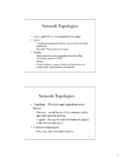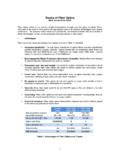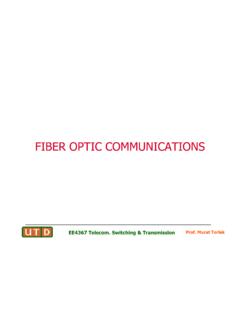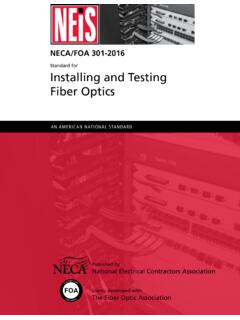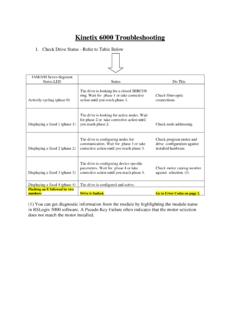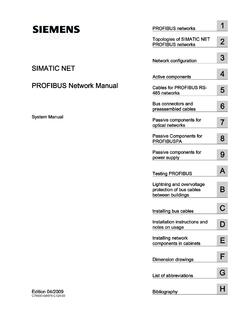Transcription of Network Topologies
1 11 Network Topologies LANs and WANs - Geographical coverage LANs A single geographical location, such as office building, school, etc Typically High speed and cheaper. WANs Spans more than one geographical location often connecting separated LANs Slower Costly hardware, routers, dedicated leased lines and complicated implementation Topologies Topology - Physical and logical Network layout Physical actual layout of the computer cables and other Network devices Logical the way in which the Network appears to the devices that use it. Common Topologies : Bus, ring, star, mesh and wireless23 Bus topology Uses a trunk or backbone to which all of the computers on the Network connect. Systems connect to this backbone using T connectors or taps. Coaxial cablings ( 10 Base-2, 10 Base5) were popular options years ago. 4 Bus TopologyDifficult to not use any specialized Network break in the cable will prevent all systems from accessing the less cableNetwork disruption when computers are added or removedCheap and easy to implementDisadvantagesAdvantages35 Ring Topology Logical ring Meaning that data travels in circular fashion from one computer to another on the Network .
2 Typically FDDI, SONET or Token Ring technology are used to implement a ring Network Ring networks are most commonly wired in a star configuration Token Ring has multi-station access unit (MSAU),equivalent to hub or switch. MSAU performs the token circulation TopologyA single break in the cable can disrupt the entire networks are moderately easy to installExpansion to the Network can cause Network disruptionCable faults are easily located, making troubleshooting easierDisadvantagesAdvantages47 Star Topology All computers/devices connect to a central device called hub or switch. Each device requires a single cable point-to-point connection between the device and hub. Most widely implemented Hub is the single point of failure8 Star TopologyMore difficult to implementEasy to troubleshoot and isolate problemsA central connecting device allows for a single point of failureCable failure affects only a single userRequires more cableEasily expanded without disruption to the networkDisadvantagesAdvantages59 Mesh Topology Each computer connects to every other.
3 High level of redundancy. Rarely used. Wiring is very complicated Cabling cost is high Troubleshooting a failed cable is tricky A variation hybrid mesh create point to point connection between specific Network devices, often seen in WAN TopologyComplicated implementationThe Network can be expanded without disruption to current usesRequires more cable than the other LAN topologiesProvides redundant paths between devicesDisadvantagesAdvantages611 Wireless networking Do not require physical cabling Particularly useful for remote access for laptop users Eliminate cable faults and cable breaks. Signal interference and security networkingLimited speed in comparison to other Network topologiesNetwork can be expanded without disruption to current usersPotential security issues associated with wireless transmissionsAllows for wireless remote accessDisadvantagesAdvantages713 IEEE and Networking standards Institute of Electrical and Electronic Engineers (IEEE) developed a series of networking standards Networking technologies developed by manufacturers are Compatible Cabling, networking devices and protocols are all interchangeable under the banner of a specific IEEE 14100 Mbps technologies, including Wireless for Interoperable LAN/MAN Security (SILS) ( Network Security) Voice and Data Technical Advisory Technical Advisory Area Network (MAN) Ring token passing ( Carrier Sense Multiple Access with Collision Detection) for Ethernet LLC(Logincal Link Control) IEEE standard Defines characteristics for Ethernet networks.
4 New additions, for Fast Ethernet for Gigabit Ethernet, referred to as .. 10gbits/s, expe. 2009 .. Speed: Original 10 Mbps, Fast Ethernet 100 Mbps, Gigabit Ethernet 1000 Mbps Topology: bus or star. Media: Coaxial and twisted pair cabling, also fiber optic cable. Access method: IEEE standard Specifies the characteristics for Token Ring Networks. Introduced by IBM in the mid 80s, Network topology of choice until the rise of the popularity of Ethernet. Speed: 4 to 16 Mbps Topology: logical ring and most often a physical star. Logical ring is often created in the Multistation Access Unit (MSAU) Media: twisted pair cabling. Access method: token passing. IEEE Standard - Wireless Specifies the characteristics of wireless LAN Ethernet networks. Special devices called wireless access points to allow communicate. Also connect to wired networks to create wireless portions of entire networks. Access method: Carrier Sense Multiple Access/Collision Avoidance(CSMA/CA ), a variation of CSMA/CD.
5 Topology: physical wireless, logical bus Protocol 1999 , 11 Mbits/s 2003 , 54 Mbits/s 2008 ,5 GHz, 248 Mbits/s ..18 FDDI Fiber Distributed Data Interface (FDDI) standard was developed by American National Standards Institute (ANSI) Dual ring technology for fault tolerance Speed: 100 Mbps or higher Topology: dual ring topology Media: fiber optic cable, > 2 kilometers. Also possible use copper wire as Copper Distributed Data Interface (CDDI). Access method: token-passing access method1019 Token passingFiber-optic Twisted pair/CDDIRingDual Ring100 MbpsFDDICSMA/CARadio passingTwisted pairRingStar 4 Mbps and pairBusStar1000 Mbps( )CSMA/CDTwisted pairBusStar100 Mbps( Fast Ethernet)( )CSMA/CDCoaxial and Twisted pairBus and MethodMediaLogical TopologyPhysical TopologySpeedStandar
